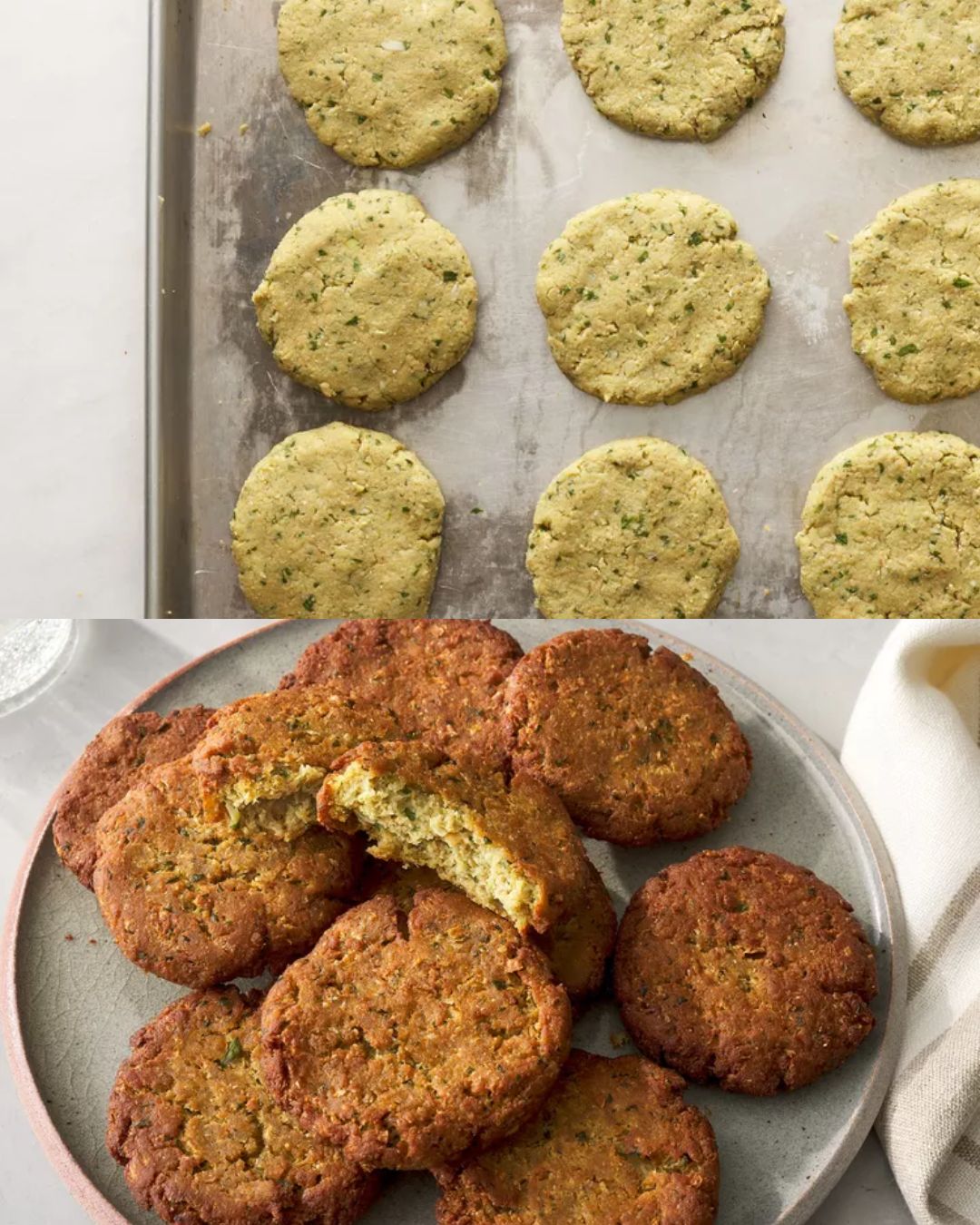Ingredients:
- 1 ½ (15 ounce) cans chickpeas, drained
- 1 ½ onions, chopped
- ¾ cup chopped fresh parsley
- 3 cloves garlic, chopped
- 2 eggs
- 1 tablespoon ground cumin
- 1 ½ teaspoons ground coriander
- 1 ½ teaspoons salt
- 1 ½ teaspoons lemon juice
- 1 ½ teaspoons baking powder
- 1 pinch ground black pepper, or to taste
- 1 pinch cayenne pepper, or to taste
- 1 ½ cups bread crumbs
- 1 tablespoon olive oil, or as needed
Steps:
1. Prepare the Chickpeas:
Start by draining and rinsing the chickpeas. If using canned chickpeas, it’s important to remove any excess liquid to ensure your falafel mixture isn’t too watery. For a smoother texture, you can also lightly mash the chickpeas with a fork or potato masher, but it’s okay to leave some of them intact for added texture.
2. Blend the Ingredients:
In a food processor, combine the chickpeas, chopped onions, garlic, parsley, cumin, coriander, salt, pepper, and cayenne. Pulse the mixture until it’s well combined but not completely smooth. You want some texture in your falafel, so avoid overprocessing. Add the lemon juice, eggs, and baking powder, and pulse a few more times to incorporate everything into a cohesive dough. If the mixture seems too wet, add a little bit more breadcrumbs until it holds together well.
3. Chill the Mixture:
Once your falafel mixture is ready, transfer it to a bowl, cover it, and refrigerate for at least 30 minutes. Chilling helps the mixture firm up, making it easier to shape into balls or patties and ensuring they hold their shape during cooking.
4. Shape the Falafel:
After the mixture has chilled, it’s time to shape your falafel. Using your hands or a spoon, take small portions of the mixture and form them into small balls, about the size of a golf ball, or flatten them into patties if you prefer. Try to keep the shape consistent so they cook evenly.
5. Fry the Falafel:
In a large skillet, heat the olive oil over medium heat. Once the oil is hot, carefully place the falafel balls into the pan, being sure not to overcrowd them. Fry the falafel for about 3-4 minutes per side, or until they are golden brown and crispy. Turn them gently to avoid breaking. Once cooked, place the falafel on a paper towel-lined plate to drain any excess oil.
6. Serve:
Serve the falafel warm, garnished with extra parsley or your favorite sauce. They’re perfect on their own, but you can also serve them with a variety of accompaniments, such as a fresh salad, pita bread, hummus, tahini, or yogurt sauce. These crispy falafel also make a delicious addition to a mezze platter, where they can be enjoyed with an assortment of Mediterranean dips and sides.
Prep Time: 15 minutes (not including chill time)
Cooking Time: 15-20 minutes
Total Time: 45 minutes (including chill time)
Servings: 4-6 servings (approximately 12-15 falafel)
Calories per Serving: Approximately 250-300 kcal (depending on the size of the falafel and oil absorption)
Why This Recipe is Timeless:
The humble falafel has been a staple in Middle Eastern cuisine for centuries, and its popularity has only grown around the world, making it a timeless dish that transcends culture and geography. What makes falafel so universally beloved is the combination of its simplicity, versatility, and satisfying flavors. Chickpeas, one of the key ingredients in falafel, have long been recognized for their health benefits, packed with protein, fiber, and essential nutrients. For vegetarians and vegans, falafel provides a rich source of plant-based protein and can serve as a filling main course when paired with a salad or wrapped in pita bread.
Falafel’s adaptability also contributes to its timeless nature. While the classic falafel recipe typically includes chickpeas, garlic, onion, and herbs, there are countless variations. Some people use fava beans instead of chickpeas, or add different herbs and spices to customize the flavor. The ability to adjust the recipe to suit personal preferences, regional variations, and available ingredients is what has made falafel an enduring favorite across cultures.
Moreover, falafel is a convenient, healthy, and cost-effective dish that can be made in bulk and served in multiple ways. Whether served as a snack, main course, or part of a larger meal, falafel is a crowd-pleaser that never goes out of style. Its crispy exterior and tender, flavorful interior ensure that it’s a comforting meal that appeals to all ages and dietary preferences.
Nutritional Facts:
- Calories per Serving: 250-300 kcal
- Total Fat: 12 g
- Carbohydrates: 30 g
- Protein: 10 g
- Cholesterol: 70 mg
- Sodium: 600 mg
- Iron: 3 mg
- Calcium: 30 mg
FAQs:
Q: Can I make falafel without eggs? A: Yes! If you’re vegan or prefer not to use eggs, you can substitute the eggs with flaxseed meal or chia seeds (mix 1 tablespoon of ground flaxseeds with 3 tablespoons of water, and let it sit for a few minutes to form a gel-like consistency). Alternatively, you can add a little more breadcrumbs to help bind the mixture together.
Q: Can I bake falafel instead of frying them? A: Absolutely! If you prefer to bake your falafel instead of frying them, preheat your oven to 375°F (190°C) and place the shaped falafel on a baking sheet lined with parchment paper. Bake for about 20-25 minutes, flipping halfway through for even crispness.
Q: How can I store leftover falafel? A: Leftover falafel can be stored in an airtight container in the fridge for up to 3 days. To reheat, you can either heat them in a skillet with a little oil or bake them in the oven at 350°F (175°C) for about 10 minutes. You can also freeze falafel for longer storage—just freeze them in a single layer, then transfer them to a freezer-safe bag. They can be reheated from frozen in the oven.
Tips for Making:
- Use Dried Chickpeas: While canned chickpeas work well, using dried chickpeas (soaked overnight) gives you a firmer, less watery texture, making the falafel easier to shape and fry.
- Don’t Overprocess: Falafel is best when the mixture still has some texture, so don’t overblend it in the food processor. A chunky mixture adds a more satisfying bite to the falafel.
- Season to Taste: If you prefer your falafel with a bit more heat, increase the amount of cayenne pepper. If you like them a little more herby, add more fresh parsley or even cilantro.
Storage Tips:
- Refrigeration: Store leftover falafel in an airtight container in the fridge for up to 3 days. They will stay tasty but may lose some of their crispiness.
- Freezing: Freeze falafel on a baking sheet in a single layer, then transfer to a freezer-safe bag or container once solid. They will last up to 3 months in the freezer. To reheat, bake or fry them from frozen.
Conclusion:
Making homemade falafel from scratch allows you to enjoy a truly authentic and flavorful dish that’s perfect for any occasion. From its rich history to its versatility and vibrant flavors, falafel is a timeless classic that brings people together. Whether you’re hosting a dinner party, enjoying a casual meal, or simply looking for a healthy, delicious snack, these crispy falafel will never disappoint.
By following this simple recipe, you’ll create falafel that’s bursting with flavor, light yet satisfying, and sure to leave a lasting impression on everyone who tries it. So gather your ingredients, get cooking, and treat yourself and your loved ones to a batch of homemade falafel that’s perfect for any time of year!

